Understanding Thermals: The Mechanics of Rising Warm Air and Buoyancy
Understanding Thermals: The Mechanics of Rising Warm Air and Buoyancy
The Basics of Thermals
Thermals are a fascinating natural phenomenon where columns of rising warm air are created due to the uneven heating of the Earth’s surface. These air currents play a crucial role in various atmospheric processes and are essential for activities like gliding and soaring.
How Thermals Form
Thermals form when the sun heats the ground, causing the air above it to warm up. This warm air becomes less dense and rises, creating a thermal. The process is influenced by several factors:
- Surface Heating: Different surfaces absorb heat at varying rates, affecting thermal formation.
- Air Density: Warm air is less dense than cool air, leading to upward movement.
- Wind Patterns: Wind can enhance or disrupt the formation of thermals.
The Role of Buoyancy
Buoyancy is a key factor in the mechanics of thermals. It refers to the upward force exerted on the warm air, allowing it to rise through the cooler surrounding air. This process is governed by the principles of fluid dynamics and is crucial for the development and sustainability of thermals.
Applications and Implications
Understanding thermals has practical applications in various fields:
- Aviation: Pilots use thermals to gain altitude without engine power, especially in gliding.
- Meteorology: Thermals influence weather patterns and cloud formation.
- Renewable Energy: Insights into thermals can improve the efficiency of solar updraft towers.
Conclusion
Thermals are a vital component of our atmosphere, driven by the principles of buoyancy and surface heating. Their understanding not only enhances our knowledge of weather patterns but also aids in various practical applications, from aviation to renewable energy. By studying the mechanics of rising warm air, we can better harness and predict these natural phenomena.






































